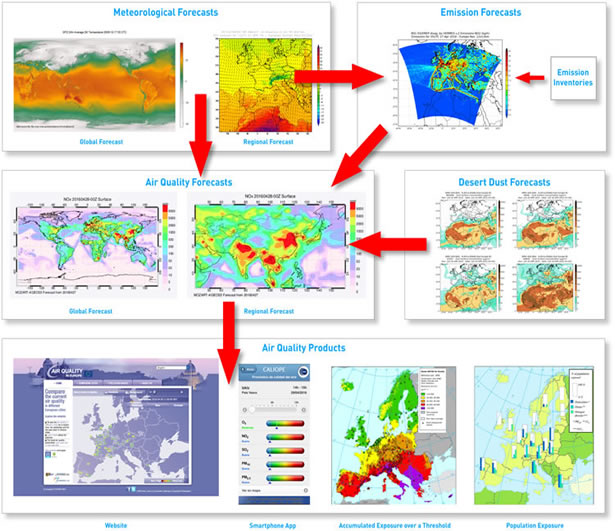Global Air Quality Forecasting and Information System (GAFIS)
"Global Air Quality Forecasting and Information System (GAFIS) Implementation Plan: 2022–2026"

Introduction
Air pollution represents a serious environmental problem. Each year, 7 million premature deaths are attributed to air pollution, with huge economic consequences – estimates indicate $5 trillion in welfare losses and $255 billion in lost income (World Bank Report, 2016). Furthermore, air pollution is detrimental for ecosystems, damages property, impacts visibility and haze, and threatens food and water security. Some pollutants such as tropospheric ozone are also climate forcers while aerosols tend to produce atmospheric cooling.
A new science for services initiative of the World Meteorological Organization (WMO) Global Atmosphere Watch (GAW) Programme --Global Air Quality Forecasting and Information System (GAFIS) will help support the health community, international partners and society, with globally consistent air quality forecasting and information systems that operate from the global to regional to urban scale.
Objectives
The high-level objective of GAFIS is: “to enable and provide air quality forecasting and information services in a globally harmonized and standardized way tailored to the needs of society”.
GAFIS will builds a platform for providers and users of air quality forecast and information systems. It will enable access to, and use of, air quality prediction and analysis products at various temporal and spatial scales and bring the atmospheric composition component to WMO’s Earth System approach for developing NWP and Climate monitoring and modelling.
GAFIS will develop harmonized standards of operations by primarily looking at existing WMO standards and in the context of the Global Data Processing and Forecasting System (GDPFS). Additionally, it will be fully inclusive, comprising operational activities as well as pre-operational and experimental ones to engage with the entire community.
GAFIS will coordinate activities to help Developing and Least Developed Countries in reaching their air quality standards and Sustainable Development Goals. GAFIS will promote that air quality related products and services freely and openly.
Implementation
GAFIS will serve as an international coordinating mechanism and establish and propagate consistent methods and standards for existing and upcoming air quality forecasting and monitoring services, as well as for air quality observations used for air quality forecast evaluation.
The GAFIS implementation plan is currently developed focusing on the following topical areas:
- Capacity development and user interaction for Air Quality Forecast and Information Systems
- Good Practice for Air Quality Forecast and Information Systems
- Observations required for Air Quality Forecast and Information Systems
- Scientific and operational synergies between Air Quality Forecasting and Numerical Weather Prediction"

Fig. Schematic overview of potential GAW service
Activities
As a first step of setting up GAFIS, we are performing the survey on the air quality forecasting system you operate and the products you provide. We encourage you to share this survey with your community to make sure a wide range AQ forecast is catalogued. The results of the survey will be shared with all participants and the air quality community. We really appreciate your taking the time and providing the input!
The survey is available here.
We share a list of entries linking to near-real-time air quality forecast, which is available here.
-
Air quality forecast intercomparisons
-
Training
To be updated.
GAFIS Steering Committee
Partners
The contributions from other partners are open. We particularly engage the WMO operational community.
Publications:
-
Global Air Quality Forecasting and Information System (GAFIS) Implementation Plan: 2022–2026
-
Training Materials and Best Practices for Chemical Weather/Air Quality Forecasting
Events and conferences
-
EGU 2023-AS1.6: Coupled modelling and data assimilation of dynamics and chemistry of the atmosphere (https://meetingorganizer.copernicus.org/EGU23/session/46816), 23–28 April 2023, Hybrid
-
SAG-APPs and GAFIS Steering Committee Meeting, 27-29 September 2022, Geneva Switzerland
-
EGU 2022-AS2.3: Coupled modelling and data assimilation of dynamics and chemistry of the atmosphere (https://meetingorganizer.copernicus.org/EGU22/session/43869), 23–27 May 2022, Hybrid
-
EGU 2021-AS5.3: Coupled modelling and data assimilation of dynamics and chemistry of the atmosphere (https://meetingorganizer.copernicus.org/EGU21/session/40828),19–30 April 2021, Online
-
JpGU - AGU Joint Meeting 2020: https://jpgu-agu2020.ipostersessions.com/Default.aspx?s=5A-B7-5B-19-E3-77-79-70-E5-40-B7-2F-9C-01-38-13, 24-28 May 2020, Online
-
EGU 2020-AS5.4: Coupled modelling and data assimilation of dynamics and chemistry of the atmosphere (https://meetingorganizer.copernicus.org/EGU2020/session/36841),4-8 May 2020, Online
